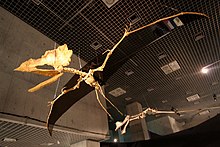Thalassodromeus sethi
|
Thalassodromeus Temporal range: Albian-Aptian |
|
|---|---|
 |
|
| Reconstructed skeleton in Japan | |
| Scientific classification | |
| Kingdom: | Animalia |
| Phylum: | Chordata |
| Class: | Reptilia |
| Order: | †Pterosauria |
| Suborder: | †Pterodactyloidea |
| Clade: | †Dsungaripteromorpha |
| Family: | †Thalassodromidae |
| Genus: |
†Thalassodromeus Kellner & Campos, 2002 |
| Species: | †T. sethi |
| Binomial name | |
|
Thalassodromeus sethi Kellner & Campos, 2002 |
|
Thalassodromeus is a genus of large pterodactyloid pterosaur found in northeastern Brazil.
It is particularly notable for its immense head crest, beginning at the tip of the snout and ending far behind the braincase, which accounts for seventy-five percent of the surface of its 1.42 metre (4.6 ft) long skull. The jaws were pointed and toothless. It had a wing span of roughly 4.5 metres (14.7 ft). The function of the crest is unknown, but it may have been used for sexual display, species recognition, or thermoregulation. A lower jaw fragment referred to Thalassodromeus, DGM 1476-M, indicates a larger example with a wingspan of 5.3 metres (17.4 ft).
The genus was named in 2002 by Alexander Kellner and Diogenes de Almeida Campos. The type species is Thalassodromeus sethi. The genus name is derived from Greek thalasse, "sea" and dromaios, "runner", in reference to its presumed life style as a skimmer. The specific name refers to the Egyptian god Seth because of the similarity in head form. In 2006 André Jacques Veldmeijer suggested Kellner had confused Seth with the god Amun whose crown shows a remarkable resemblance with the Thalassodromeus head crest.
The genus is based on the holotype DGM 1476-R, a damaged partial skull, found in the Santana Formation. Thalassodromeus lived in the Early Cretaceous (Aptian to Albian). It shared the skies with its smaller cousin Tapejara.
Another jaw fragment, SAO 251093, was unofficially suggested to be a new species, "Thalassodromeus oberli" (referring to the Urs Oberli collection), by Veldmeijer in 2006, after having referred the specimen to T. sethi in 2005. In 2014 this was made a separate genus Banguela.
...
Wikipedia
